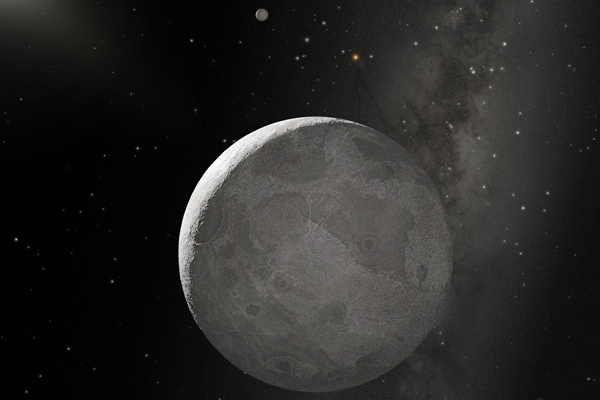Other & provisional moons
Contents
Haumea's Moons
 Concept of Haumea and its two moons (Hi'iaka and Namaka) / cgsociety.org
Concept of Haumea and its two moons (Hi'iaka and Namaka) / cgsociety.orgCurrently, there have only been two moons that have been discovered in orbit around Haumea (Namaka and Hi'iaka). At this time, we do not have much information on these two moons other than they appear to be similar in shape and design as Haumea, only much dimmer and smaller in size.
Eris' Moons
 Concept of Eris and its moon Dysnomia / hubblesite.org
Concept of Eris and its moon Dysnomia / hubblesite.orgEris currently has only a single moon, Dysnomia, and other than speculations little else is known about this moon.
Provisional Moons
A provisional moon is a discovered object in orbit around a parent object. These moons have not been named as of yet and are given a temporary (provisional) name for identifications purposes. The names are designated as S (satellite)/year discovered first initial of parent object discovery number. For instance S/2003 J12 was a satellite/discovered in 2003 orbiting Jupiter and was the 12 "moon" to be discovered in Jupiter's orbit. These are the provisional moons that are currently known in our solar system. There is little information usually available for these moons because their discovery is still fairly recent.
Note: Jupiter having the most amount of moons in the solar system, many of them have been placed in groups. Some of the provisional moons have been designated to these groups as well. Those who have not been placed in a group have been listed here all others have been placed under the group under their "parent".
S/2003 J 2 — at the same time that Carpo was founded, S/2003 J2 was also discovered but has yet to be named. It is believed that S/2003 J2 is a smaller asteroid that was caught by Jupiter's pull and is approximately 1 km (.62 miles) across.
S/2003 J 12 — sitting at approximately 17.8 million km (12.2 million miles) from Jupiter, S/2003 J12 was discovered between February and March of 2003. It was discovered while observations of Jupiter's moons revealed more moons in its orbit.
S/2009 S 1 — little is known about this moon as it was just discovered in a photograph in 2009 taken by the Cassini probe. Discovered by it's "shadow" in Saturn's B-ring, it is believed to be no more than 300 meters (980 feet) in size, too small to be seen other then by it's "propeller" hence it is called a "propeller" moon.
S/2010 J 1 — was discovered in 2010 and is approximately 3 km (1.8 miles). Its distance from Jupiter is 23.5 million km (14.6 million miles) and takes about 2 years to complete its orbit around the planet.
S/2010 J 2 — was discovered in 2010 and has an orbital path that takes 1.7 years. It has an average distance from Jupiter of 21 million km (13.1 million miles). It is approximately 1 km (.62 miles) and has been labeled as the smallest moon in the solar system found from Earth.
S/2011 J 1 — founded by Scott Shepard in 2011, no information is available at this time for this Jupiter moon.
S/2011 J 2 — founded by Scott Shepard in 2011, no information is available at this time for this Jupiter moon.
S/2015 (136472) 1 — in 2015, a new moon was discovered orbiting around the dwarf planet MakeMake in the Kuiper Belt. Nicknamed MK 2, there is very little known about this new dark moon other than it appears to be approximately 100 miles (160 km) in size.
S/2004 N 1 — was discovered in 2013. It is approximately 11 miles (18 km) in size and orbits Neptune in just under a day. The moon is so dim, the Voyager 2 did not pick it up in 1989 but the SETI Institutes Mark Showalter noticed this tiny moon in photographs he pulled from the archives. When giving the moon a designation, they chose to use the year it was recorded rather than when it was actually noticed which is why it has the year 2004 instead of 2013.
See also: All satellites and moons